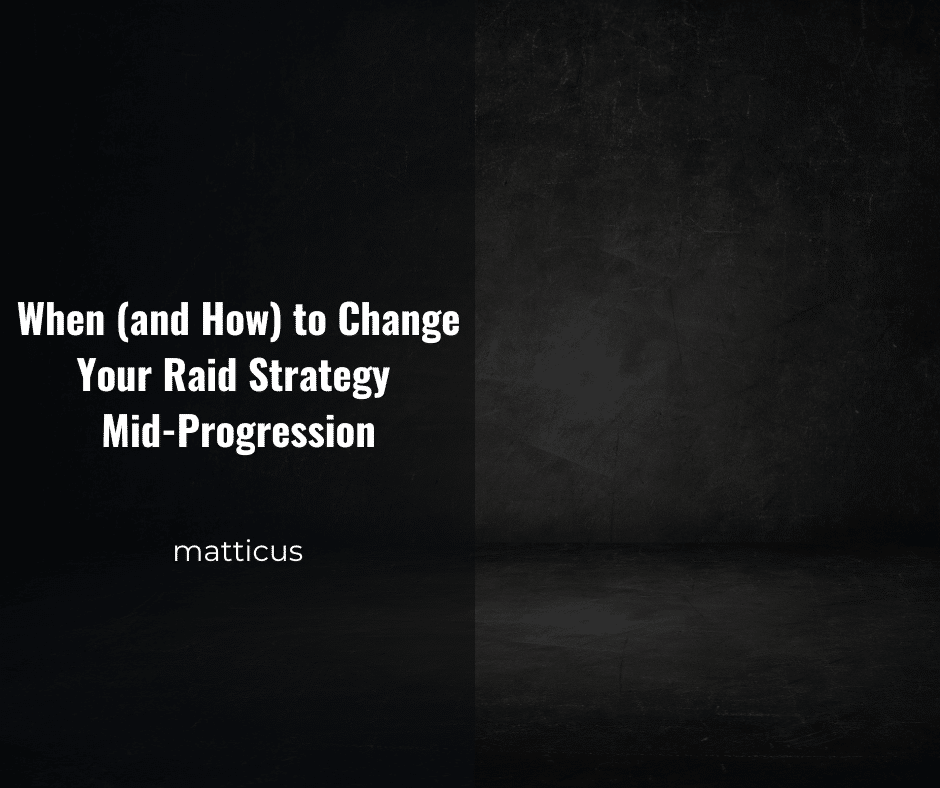Although we killed Mug’zee last night in Last Call, I wanted to put pen to paper on a strategy change last week that didn’t ultimately work out well for us.
Our raid progression is never linear. It tends to crescendo and decrescendo. Your team strategizes, plans carefully, and yet sometimes the team hits a wall. That’s exactly where we found ourselves recently on Mug’zee.
With a fresh 3% DPS buff for our raid (15%), we saw an opportunity. Maybe we could shake things up, make an aggressive strategic pivot, and secure the kill faster than anticipated.
But the thing about strategic changes is that they’re easy to plan, but a lot trickier to execute.
Strategy Change Fundamentals
Before diving in, let’s cover why you might even consider shifting gears in the middle of progression. Generally, you look at:
- Significant raid-wide buffs or nerfs (like we received).
- Roster adjustments (for us, going from 4 healers down to 3).
- Persistent performance issues or plateaus where your current approach feels stuck.
These pivots aren’t guesses. They’re carefully calculated risks that raid leaders take, hoping for a big payoff (like skipping an entire problematic phase, such as the 3 Gaol set).
Why We Made the Change
The newly implemented 3% DPS buff felt like our window of opportunity. We previously planned for a 4-minute DPS push on Mug’zee. But with the added firepower, a tighter 3-minute push strategy suddenly felt achievable, letting us bypass the notoriously dangerous “third jail set.”
To enable this, we made the call to drop from 4 healers to just 3, adding one more DPS to meet our new aggressive goal. It was bold. But the math checked out (on paper, anyway).
The Reality Check
Initial pulls seemed promising, but reality quickly set in. With one fewer healer, we felt the squeeze immediately. Damage was higher than anticipated, healer mana started running dangerously low, and our throughput suffered. Our mine popping was no longer consistent, and we suffered sporadic deaths.
Despite careful planning, something became clear fast: our margin for error had shrunk drastically. Mechanics we used to comfortably heal through suddenly became critical threats.
What We Learned (And Why It Wasn’t a Mistake)
Did we secure the kill with the new aggressive strategy? No. But we got something valuable: a clear understanding of our actual DPS and healing thresholds. We identified exactly what we needed for the faster push, and it gave us concrete data.
We pivoted back halfway through the night, returning to the safer, original 4-minute strategy, and immediately saw results. Our best pull got Mug’zee down to 0.4%, proving our initial instincts were fundamentally solid.
Timing and Feedback: What Could’ve Gone Better
One notable hiccup: we waited too long to fully engage our healers for their feedback. It wasn’t until our mid-raid break that we stopped to reassess and found ourselves burning valuable raid minutes sorting things out. In hindsight, quick temperature checks after the first few attempts would’ve saved us significant time. We should have asked healers more frequently (maybe every 20 minutes or so). We still needed to give them a few reps to get accustomed to the change in damage coming in.
Early and frequent feedback loops are essential during major strategy shifts.
Raiders Grumbling? That’s Normal (and Okay)
Naturally, not everyone was thrilled. Some raiders grumbled about the mid-raid strategy pivot, suggesting we should never have tried it in the first place. It’s always easy to say that in hindsight, knowing how things played out. But the truth is, strategic adaptability means accepting uncertainty while failing to gain knowledge.
I still stand firmly by our decision to try. There was undeniable value in the potential to skip an entire challenging phase. It felt mathematically possible with 3 healers, but achieving that strategy would’ve required an exceptionally high individual skill ceiling. Realistically, getting there would’ve taken far more pulls and raid hours than we wanted to commit at this stage.
Best Practices for Handling Strategy Pivots
Here’s how you can manage similar situations better:
- Quick Feedback Loops:
Check in with key players and roles (especially healers and tanks) after just a few pulls to gauge viability. - Clearly Defined “Pivot Indicators”:
Decide in advance how you’ll measure if the new approach is worth sticking with. Set those benchmarks! - Always Have a Backup Plan:
Know when to switch back decisively.
Final Thoughts: Adaptability is Leadership
Strategic pivots aren’t failures. These leadership decisions are designed to push the team forward, even if they don’t always pan out. We might not have achieved the 3-minute push, but thanks to what we learned, we were able to secure a clean (or dirty) kill using the original strategy.
Raid leadership is about managing calculated risks and adapting quickly. Even if you fall short, you’re still one step closer.
We’re on to Gallywix!
